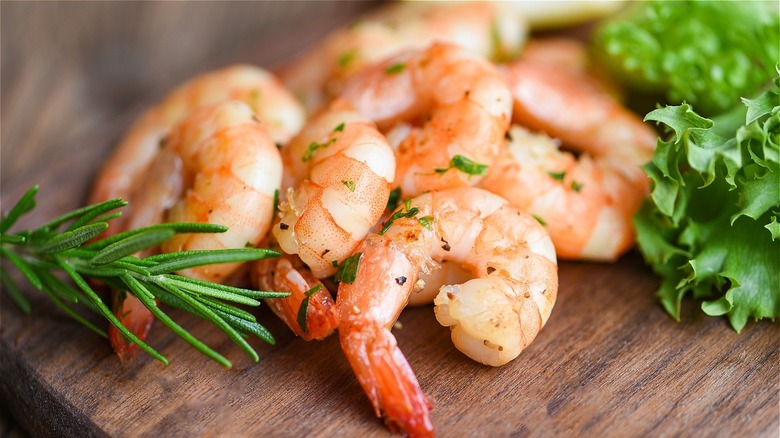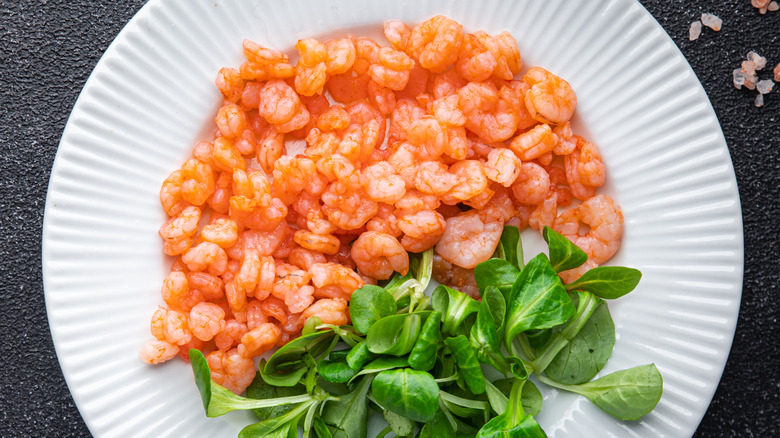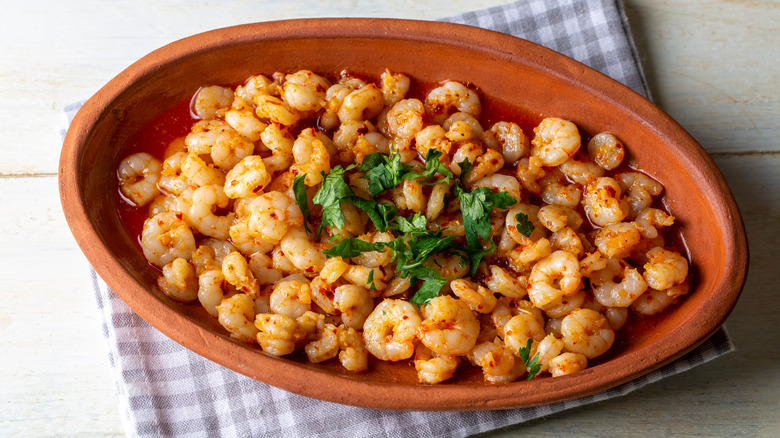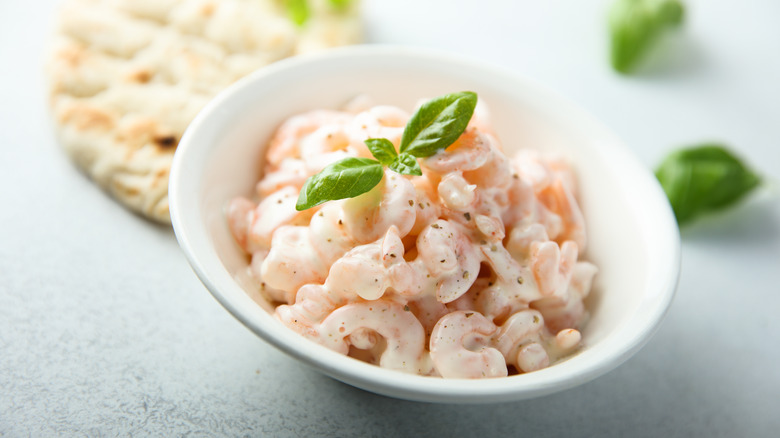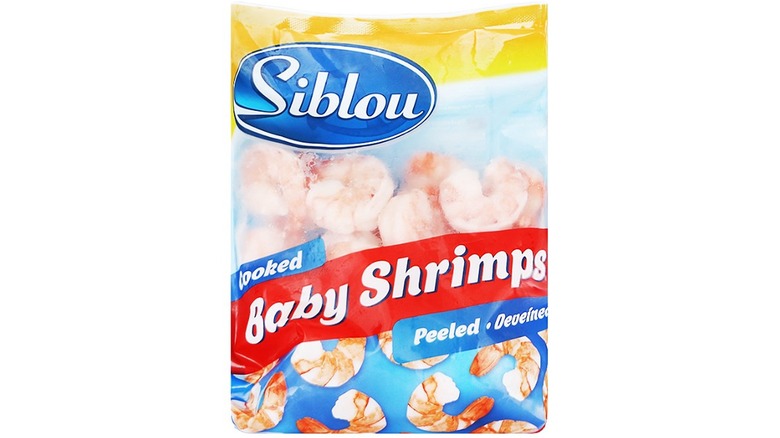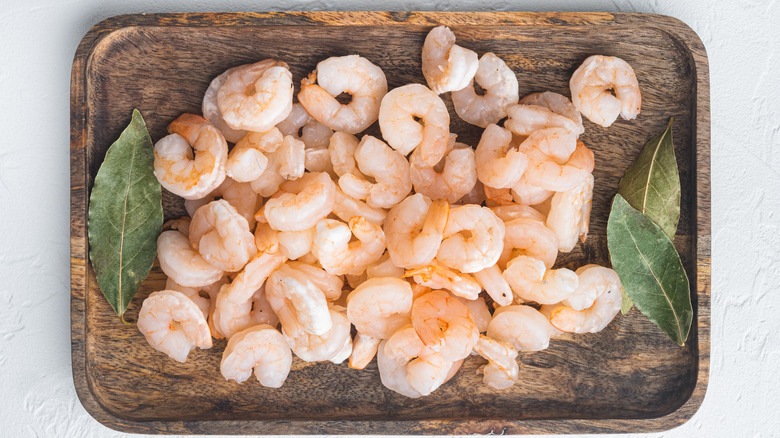What Exactly Are Baby Shrimp And How Do You Avoid Overcooking Them?
Shrimp is such a funny food if you think about it. Not the taste, which we're actually quite fond of, but the name: Shrimp is synonymous with small or even tiny, and yet if you go shopping in the frozen seafood aisle at the supermarket you may find packages labeled colossal, jumbo, extra-large, large, and medium. Small-size shrimp aren't so easy to come by, though, and you may have to look even harder to dig up a package of the one kind of shrimp that's truly shrimpy: baby shrimp.
When it comes to shrimp, it's the plus sizes that are more popular (kind of the opposite of the fashion industry where single digits rule the runway). Jumbo shrimp are actually considered standard for recipes, much in the same way that large eggs are standard for baking. Baby shrimp, which are also known as salad shrimp or tiny shrimp, do have a price advantage, though, as they tend to be somewhat cheaper than the larger kind. What's more, they are much more likely to come already peeled and de-veined. That being said, they do have their disadvantages, chief among them the fact that anything so itty bitty can be extra tough not to overcook. We'll make like a marine shrimp and take a deep dive into this subject later, but the secret seems to be that baby shrimp barely need any cooking at all.
What are baby shrimp?
Baby shrimp are designated by their size, not their species (nor are they actually babies age-wise). There are no universally accepted size standards adopted by all shrimp producers, so some shrimp experts will insist that you go by the numbers when shrimp shopping and select, for example, a bag marked 26/30 (this refers to the number you'll find in a pound). Many recipes, however, don't go into so much detail, so it helps to know that shrimp bearing that label might also be considered extra-large. While the largest of shrimp may number a dozen or fewer per pound, a pound of baby shrimp, at the other end of the spectrum, could consist of 100 or more diminutive crustaceans.
As to the species, here's a surprising fact: edible shrimp come in a wide variety. In fact, they don't all share the same genus, either. Most shrimp that we eat fall under the rough headings of white, pink, or brown, though, designations that refer to the color of the shrimp when raw (all shrimp are pink once they've been cooked). Several shrimp species run small, so these are the ones that primarily tend to be caught and sold as baby or salad shrimp: Oregon pink shrimp (Pandalus jordani), humpy shrimp (Pandalus goniurus), and Maine or Northern shrimp (Pandalus borealis).
What do baby shrimp taste like?
Baby shrimp, and indeed all sizes of shrimp, have a very mild flavor compared to most other types of seafood. That is what makes shrimp such a versatile ingredient as it, like chicken, takes on the flavor of any sauces or seasonings with which it is cooked. If eaten on its own, shrimp tastes somewhat sweet and may also have a bit of brine to it that speaks of its saltwater origins unless it's freshwater shrimp (in which case it's less salty). As baby shrimp are the smallest type of edible shrimp, they often have the mildest and least fishy flavor. They can also be more tender and less chewy than their larger counterparts, particularly as some larger shrimp may be older and shrimp tends to toughen up with age.
When baby shrimp go bad, though, they will start to develop some "off" flavors that could be an indication that they're no longer safe to consume. Shrimp can be safely stored in the freezer forever and a day (barring any unseen power failures), but they'll only last in the fridge for maybe two days. After that, they may start to smell fishy or ammonia-like, and the taste, should you be foolhardy enough to cook and eat them, could be sour or rancid.
How to cook (but not overcook) baby shrimp
Baby shrimp, due to their extra-small size, may not be the kind of thing you would want to batter and deep-fry, but they lend themselves well to being used in salads (hence the alternate name of salad shrimp). They can also be ground up to use as a paste or a dumpling filling or chopped fine to make shrimp cakes (which are like crab cakes, only shrimpy) or shrimp burgers (like Krabby patties, only ... you get it). Other ways to use them include stirring them into shrimp fried rice or omelets and adding them to pasta sauce. If you're using frozen or fresh baby shrimp, these will need to be cooked, but not for very long — just a minute or two ought to do it.
Canned baby shrimp, however, come pre-cooked so it's best to add these to a dish right at the end or perhaps just sprinkle them on top after it's done cooking. If you use them to top a just-baked pizza, for example, the residual heat from the sauce and melted cheese will warm them right up without unnecessarily cooking them any further. If you are using canned baby shrimp in a cold dish like shrimp salad, there's also no need to cook them. Simply stir in some mayonnaise and seasonings and you'll be good to go.
Where to buy baby shrimp
If you want freshly caught baby shrimp, you may be able to find them at a fish market, assuming, that is, that you live anywhere in the vicinity of where said shrimp are likely to have been caught. If the market is any distance away from the docks, though, you'd better hope those shrimp have been frozen. Frozen baby shrimp can also be purchased from an online fish market if you want them to come with a provenance, or from the supermarket if you prefer getting them at a good price.
Canned baby shrimp, too, are available in supermarkets, although they won't be located in the seafood section but more likely in the canned meats aisle alongside the tuna. You may also find baby shrimp in dried form in the Asian foods aisle as these can be rehydrated for use in stir-fries, soups, and dumpling fillings. Yet another way you might be able to find dried baby shrimp is through Amazon.
Nutritional information about baby shrimp
Shrimp of all sizes have a similar nutritional value. No matter how many pieces it contains, a 3-ounce serving will come in at a mere 84 calories, per the USDA. As with most meats, shrimp (baby and otherwise) is very low in carbohydrates, with just .17 grams in that same serving (though some non-USDA sources claim shrimp are carb-free). The fat content, too, is practically nonexistent, coming in at just .24 grams. Shrimp is high in protein, however, packing a hefty 20 grams into that small portion. It's also a good source of iodine, omega-3s, and antioxidants.
Still, baby (and other) shrimp do have other nutritional features to consider. Their 161 milligrams of cholesterol per serving are on the high side for that nutrient. Canned versions may go even higher. Bumblebee's tiny shrimp, which come in 3.9-ounce servings, packs about 240 grams of cholesterol. They also contain significantly more sodium, providing 650 milligrams per 3.9-ounce can as opposed to the 94 milligrams found in 3 ounces of the non-canned kind. There's also the potential for farm-raised shrimp to contain antibiotics.
Other need-to-know info about shrimp includes the fact that they can pose an allergy risk for many people. A severe reaction can include anaphylactic shock which is potentially fatal if not treated in a timely fashion, and it's possible for someone sensitive to shrimp to be harmed merely by exposure to the fumes caused by cooking the crustacean.
